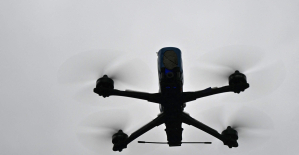For the first time, the US space agency Nasa has intentionally let a spacecraft fly into an asteroid in order to change its trajectory. The NASA probe Dart raced into the asteroid moon Dimorphos at more than 20,000 kilometers per hour on Tuesday night, as can be seen on live images. "Impact confirmed for world's first planetary defense test mission," NASA announced. With the mission, she wants to test whether and how she can protect Earth from approaching celestial bodies.
The probe for the spectacular experiment "Double Asteroid Redirection Test" (Dart for short) was launched in November 2021 in California. On Tuesday morning, at 1:14 a.m. CEST, it hit the asteroid moon Dimorphos, which orbits the asteroid Didymos eleven million kilometers from Earth.
At the control center in Laurel, Maryland, engineers and scientists erupted in cheers when the transmission ended after the collision. "We're entering a new era -- an era where we might be able to protect ourselves from something like a dangerous asteroid impact," said Lori Glaze, NASA's chief of planetary science.
Dimorphos, which is about the size of an Egyptian pyramid with a diameter of 160 meters, was first seen as a patch of light on NASA's live images about an hour before the collision. In the last few minutes before impact with the probe, which was about the size of a car, even its rocky surface could be seen.
With the experiment, NASA wants to test whether it is possible to change the course of an asteroid. The orbit of Dimorphos is to be slightly changed as a result of the impact: the orbital period of just under twelve hours is to be shortened by up to ten minutes. To steer a dangerous asteroid past Earth would require only minimal course changes with early intervention.
The probe itself was destroyed in the collision with Dimorphos. A few minutes after the impact, however, a small satellite, which undocked from the spacecraft a few weeks ago, should fly past the collision site and provide close-up pictures of it. However, it will take weeks and months for these images to reach Earth. Telescopes on Earth and in space, including the extremely powerful James Webb telescope, will also observe the experiment.
For an even more detailed investigation, the European Space Agency (ESA) wants to send out its probe Hera in 2024, which should reach the asteroid two years later. The mission, in which the German Aerospace Center (DLR) is significantly involved, is to analyze the nature of Dimorphos and the effects of the impact.
Of the billions of asteroids and comets in our solar system, very few are classified as potentially dangerous to Earth. No impact is expected for the next 100 years. But "I guarantee you, if you wait long enough, there will be an object," said NASA chief scientist Thomas Zurbuchen.
This is also taught by space history: about 66 million years ago, the Chicxulub asteroid, which is about ten kilometers in size, hit what is now Mexico. It ensured a long winter and is associated with the extinction of the dinosaurs and three quarters of all other species at that time. The impact of an asteroid the size of Dimorphos would only have regional effects. But it would have more force than any atomic bomb and could destroy an entire city.

 Russia: schools will train children to use drones at the start of the school year
Russia: schools will train children to use drones at the start of the school year Austria: incestuous torturer Josef Fritzl, nicknamed the “national monster”, could soon be released
Austria: incestuous torturer Josef Fritzl, nicknamed the “national monster”, could soon be released An airline continues to treat a centenarian as a one-year-old baby
An airline continues to treat a centenarian as a one-year-old baby Germany: the trial of nine “Citizens of the Reich” conspirators begins this Monday
Germany: the trial of nine “Citizens of the Reich” conspirators begins this Monday Sánchez cancels his agenda and considers resigning: "I need to stop and reflect"
Sánchez cancels his agenda and considers resigning: "I need to stop and reflect" The Federal Committee of the PSOE interrupts the event to take to the streets with the militants
The Federal Committee of the PSOE interrupts the event to take to the streets with the militants Repsol: "We want to lead generative AI to guarantee its benefits and avoid risks"
Repsol: "We want to lead generative AI to guarantee its benefits and avoid risks" Osteoarthritis: an innovation to improve its management
Osteoarthritis: an innovation to improve its management Sanofi: demonstration in front of Paris headquarters against job cuts
Sanofi: demonstration in front of Paris headquarters against job cuts The Chinese car manufacturer BYD sets out to conquer France
The Chinese car manufacturer BYD sets out to conquer France Public finances: after the deputies, Bruno Le Maire asks the senators for savings avenues
Public finances: after the deputies, Bruno Le Maire asks the senators for savings avenues Faced with opposition from London, a fund supported by Abu Dhabi abandons the purchase of the Daily Telegraph
Faced with opposition from London, a fund supported by Abu Dhabi abandons the purchase of the Daily Telegraph Omar Sy on all cultural fronts
Omar Sy on all cultural fronts Jacques Audiard, Swann Arlaud, Benjamin Stora... A hundred men from cinema, theater and books in support of
Jacques Audiard, Swann Arlaud, Benjamin Stora... A hundred men from cinema, theater and books in support of Resale, scams and fake tickets: how not to get scammed before Taylor Swift concerts
Resale, scams and fake tickets: how not to get scammed before Taylor Swift concerts Isild Le Besco is not ready to file a complaint against Benoît Jacquot
Isild Le Besco is not ready to file a complaint against Benoît Jacquot Omoda 7, another Chinese car that could be manufactured in Spain
Omoda 7, another Chinese car that could be manufactured in Spain BYD chooses CA Auto Bank as financial partner in Spain
BYD chooses CA Auto Bank as financial partner in Spain Tesla and Baidu sign key agreement to boost development of autonomous driving
Tesla and Baidu sign key agreement to boost development of autonomous driving Skoda Kodiaq 2024: a 'beast' plug-in hybrid SUV
Skoda Kodiaq 2024: a 'beast' plug-in hybrid SUV The home mortgage firm rises 3.8% in February and the average interest moderates to 3.33%
The home mortgage firm rises 3.8% in February and the average interest moderates to 3.33% This is how housing prices have changed in Spain in the last decade
This is how housing prices have changed in Spain in the last decade The home mortgage firm drops 10% in January and interest soars to 3.46%
The home mortgage firm drops 10% in January and interest soars to 3.46% The jewel of the Rocío de Nagüeles urbanization: a dream villa in Marbella
The jewel of the Rocío de Nagüeles urbanization: a dream villa in Marbella Europeans: a senior official on the National Rally list
Europeans: a senior official on the National Rally list Blockade of Sciences Po: the right denounces a “drift”, the government charges the rebels
Blockade of Sciences Po: the right denounces a “drift”, the government charges the rebels Even on a mission for NATO, the Charles-de-Gaulle remains under French control, Lecornu responds to Mélenchon
Even on a mission for NATO, the Charles-de-Gaulle remains under French control, Lecornu responds to Mélenchon “Deadly Europe”, “economic decline”, immigration… What to remember from Emmanuel Macron’s speech at the Sorbonne
“Deadly Europe”, “economic decline”, immigration… What to remember from Emmanuel Macron’s speech at the Sorbonne These French cities that will boycott the World Cup in Qatar
These French cities that will boycott the World Cup in Qatar Bayern Munich-Real Madrid: in video, all the goals from the C1 clash
Bayern Munich-Real Madrid: in video, all the goals from the C1 clash Ligue 1: Zaire-Emery, Yoro, Roy, Griezmann... The others nominated for the UNFP Trophies
Ligue 1: Zaire-Emery, Yoro, Roy, Griezmann... The others nominated for the UNFP Trophies Bayern Munich-Real Madrid: in video, the magnificent tifo in tribute to Franz Beckenbauer
Bayern Munich-Real Madrid: in video, the magnificent tifo in tribute to Franz Beckenbauer Ayrton Senna: 30 anecdotes that you (perhaps) don't know about the Brazilian who died thirty years ago
Ayrton Senna: 30 anecdotes that you (perhaps) don't know about the Brazilian who died thirty years ago
















